Paper Menu >>
Journal Menu >>
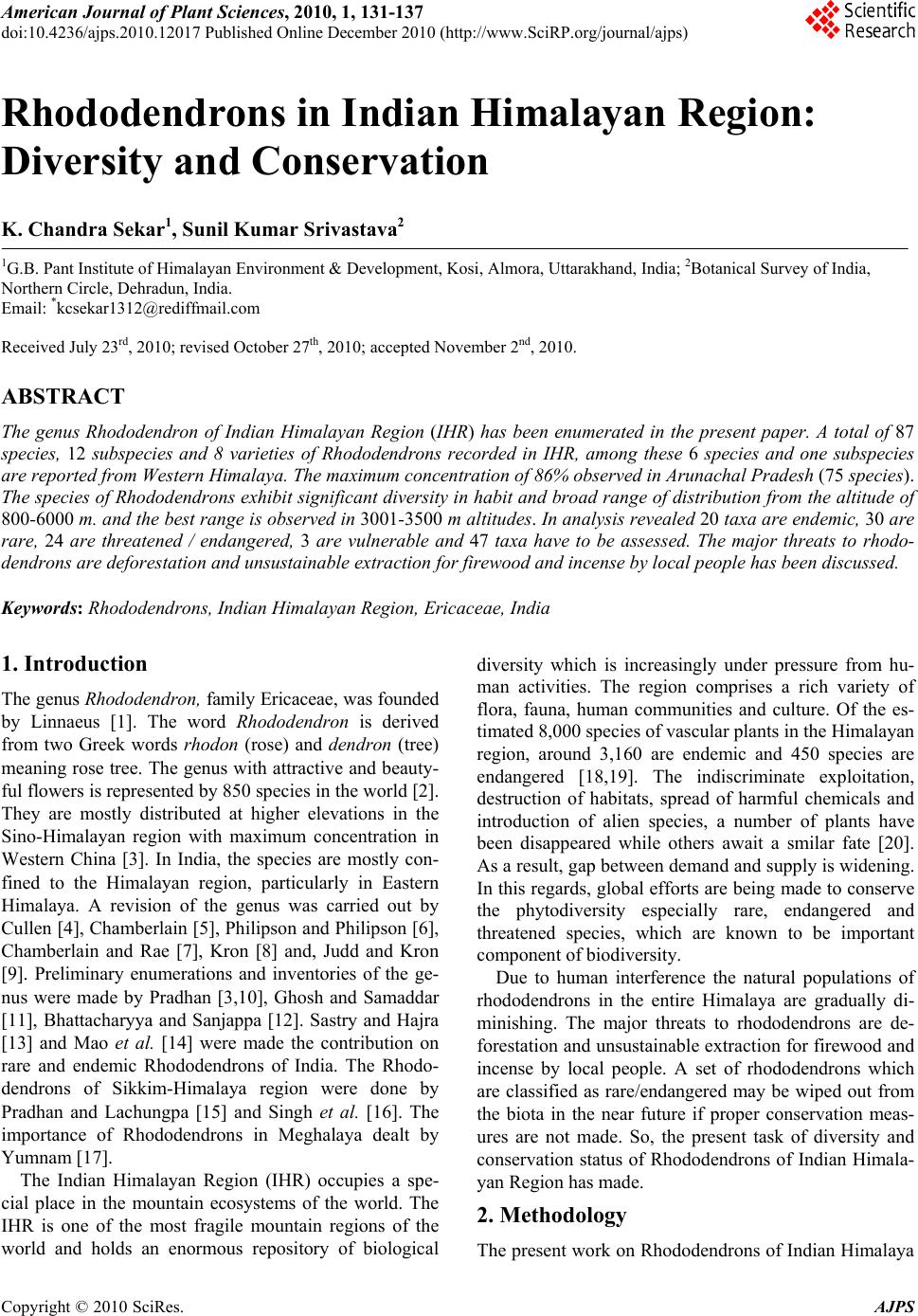 American Journal of Plant Sciences, 2010, 1, 131-137 doi:10.4236/ajps.2010.12017 Published Online December 2010 (http://www.SciRP.org/journal/ajps) Copyright © 2010 SciRes. AJPS 131 Rhododendrons in Indian Himalayan Region: Diversity and Conservation K. Chandra Sekar1, Sunil Kumar Srivastava2 1G.B. Pant Institute of Himalayan Environment & Development, Kosi, Almora, Uttarakhand, India; 2Botanical Survey of India, Northern Circle, Dehradun, India. Email: *kcsekar1312@rediffmail.com Received July 23rd, 2010; revised October 27th, 2010; accepted November 2nd, 2010. ABSTRACT The genus Rhododendron of Indian Himalayan Region (IHR) has been enumerated in the present paper. A total of 87 species, 12 subspecies and 8 varieties of Rhododendrons recorded in IHR, among these 6 species and one subspecies are reported from Western Himalaya. The maximum concentration of 86% observed in Arunachal Pradesh (75 species). The species of Rhododendrons exhibit sig nificant diversity in habit and broad rang e of distribution from the altitude of 800-6000 m. and the best range is observed in 3001-3500 m a ltitudes. In analysis revealed 20 taxa are endemic, 30 are rare, 24 are threatened / endangered, 3 are vulnerable and 47 taxa have to be assessed. The major threats to rhodo- dendrons are deforestation and unsustainable extraction for firewood and incense by local people has been discussed. Keywords: Rhododendrons, Indian Himalayan Region, Ericaceae, India 1. Introduction The genus Rhododendron, family Ericaceae, was founded by Linnaeus [1]. The word Rhododendron is derived from two Greek words rhodon (rose) and dendron (tree) meaning rose tree. The genus with attractive and beauty- ful flowers is represented by 850 species in the world [2]. They are mostly distributed at higher elevations in the Sino-Himalayan region with maximum concentration in Western China [3]. In India, the species are mostly con- fined to the Himalayan region, particularly in Eastern Himalaya. A revision of the genus was carried out by Cullen [4], Chamberlain [5 ], Philipson and Philipson [6], Chamberlain and Rae [7], Kron [8] and, Judd and Kron [9]. Preliminary enumerations and inventories of the ge- nus were made by Pradhan [3,10], Ghosh and Samaddar [11], Bhattacharyya and Sanjappa [12]. Sastry and Hajra [13] and Mao et al. [14] were made the contribution on rare and endemic Rhododendrons of India. The Rhodo- dendrons of Sikkim-Himalaya region were done by Pradhan and Lachungpa [15] and Singh et al. [16]. The importance of Rhododendrons in Meghalaya dealt by Yumnam [17]. The Indian Himalayan Region (IHR) occupies a spe- cial place in the mountain ecosystems of the world. The IHR is one of the most fragile mountain regions of the world and holds an enormous repository of biological diversity which is increasingly under pressure from hu- man activities. The region comprises a rich variety of flora, fauna, human communities and culture. Of the es- timated 8,000 species of vascular plants in the Himalayan region, around 3,160 are endemic and 450 species are endangered [18,19]. The indiscriminate exploitation, destruction of habitats, spread of harmful chemicals and introduction of alien species, a number of plants have been disappeared while others await a smilar fate [20]. As a result, gap between demand and supply is widening. In this regards, global efforts are being made to conserve the phytodiversity especially rare, endangered and threatened species, which are known to be important component of biodiversity. Due to human interference the natural populations of rhododendrons in the entire Himalaya are gradually di- minishing. The major threats to rhododendrons are de- forestation and unsustainable extraction for firewood and incense by local people. A set of rhododendrons which are classified as rare/endangered may be wiped out from the biota in the near future if proper conservation meas- ures are not made. So, the present task of diversity and conservation status of Rhododendrons of Indian Himala- yan Region has made. 2. Methodology The present wo rk on Rhododendro ns of Indian Himalay a 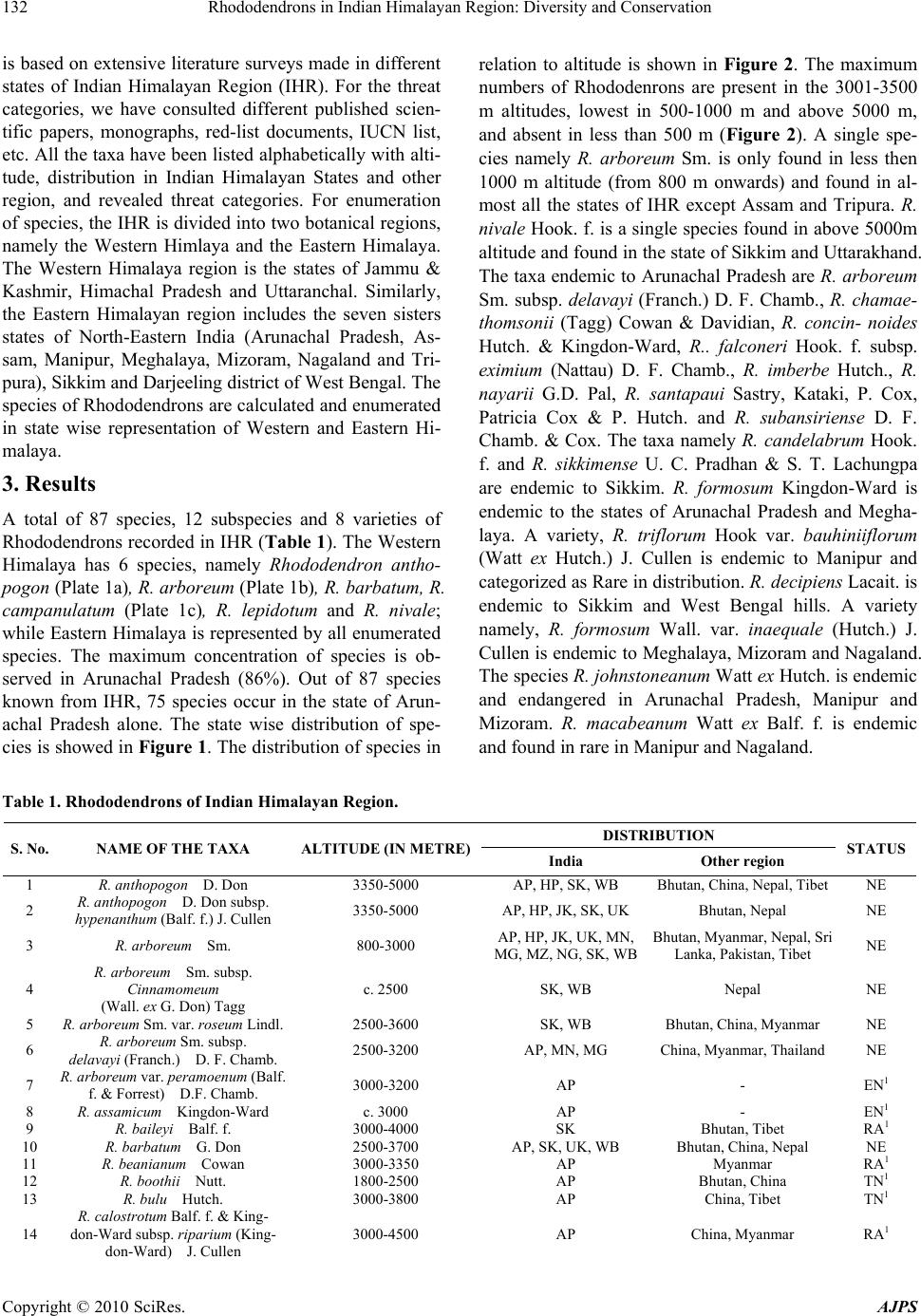 Rhododendrons in Indian Himalayan Region: Diversity and Conservation Copyright © 2010 SciRes. AJPS 132 is based on extensiv e literature surveys made in different states of Indian Himalayan Region (IHR). For the threat categories, we have consulted different published scien- tific papers, monographs, red-list documents, IUCN list, etc. All the taxa have been listed alphabetically with alti- tude, distribution in Indian Himalayan States and other region, and revealed threat categories. For enumeration of species, the IHR is divided into two botanical regions, namely the Western Himlaya and the Eastern Himalaya. The Western Himalaya region is the states of Jammu & Kashmir, Himachal Pradesh and Uttaranchal. Similarly, the Eastern Himalayan region includes the seven sisters states of North-Eastern India (Arunachal Pradesh, As- sam, Manipur, Meghalaya, Mizoram, Nagaland and Tri- pura), Sikkim and Darjeeling district of West Bengal. The species of Rhododen drons are calculated and enumerated in state wise representation of Western and Eastern Hi- malaya. 3. Results A total of 87 species, 12 subspecies and 8 varieties of Rhododendrons r ecorded in IHR (Tab le 1). The Western Himalaya has 6 species, namely Rhododendron antho- pogon (Plate 1a), R. arboreum (Plate 1b), R. barba tum, R. campanulatum (Plate 1c), R. lepidotum and R. nivale; while Eastern Himalaya is represented by all enumerated species. The maximum concentration of species is ob- served in Arunachal Pradesh (86%). Out of 87 species known from IHR, 75 species occur in the state of Arun- achal Pradesh alone. The state wise distribution of spe- cies is showed in Figure 1. The distribution of species in relation to altitude is shown in Figure 2. The maximum numbers of Rhododenrons are present in the 3001-3500 m altitudes, lowest in 500-1000 m and above 5000 m, and absent in less than 500 m (Figure 2). A single spe- cies namely R. arboreum Sm. is only found in less then 1000 m altitude (from 800 m onwards) and found in al- most all the states of IHR except Assam and Tripura. R. nivale H ook. f. is a single species found in abov e 5000m altitude and found in the state of Sikkim and Uttarakhan d. The taxa endemic to Arunachal Pradesh are R. arboreum Sm. subsp. delavayi (Franch.) D. F. Chamb., R. chamae- thomsonii (Tagg) Cowan & Davidian, R. concin- noides Hutch. & Kingdon-Ward, R.. falconeri Hook. f. subsp. eximium (Nattau) D. F. Chamb., R. imberbe Hutch., R. nayarii G.D. Pal, R. santapaui Sastry, Kataki, P. Cox, Patricia Cox & P. Hutch. and R. subansiriense D. F. Chamb. & Cox. The taxa namely R. candelabrum Hook. f. and R. sikkimense U. C. Pradhan & S. T. Lachungpa are endemic to Sikkim. R. formosum Kingdon-Ward is endemic to the states of Arunachal Pradesh and Megha- laya. A variety, R. triflorum Hook var. bauhiniiflorum (Watt ex Hutch.) J. Cullen is endemic to Manipur and categorized as Rare in distribution. R. decipiens Lacait. is endemic to Sikkim and West Bengal hills. A variety namely, R. formosum Wall. var. inaequale (Hutch.) J. Cullen is endemic to Meghalaya, Mizoram and Nagaland. The species R. johnstoneanum Watt ex Hutch. is endemic and endangered in Arunachal Pradesh, Manipur and Mizoram. R. macabeanum Watt ex Balf. f. is endemic and found in rare in Manipur and Nagaland. Table 1. Rhododendrons of Indian Himalayan Region. DISTRIBUTION S. No. NAME OF THE TAXA ALTITUDE (IN METRE)India Other region STATUS 1 R. anthopogon D. Don 3350-5000 AP, HP, SK, WB Bhutan, China, Nepal, TibetNE 2 R. anthopogon D. Don subsp. hypenanthum (B alf. f.) J. Cul l en 335 0-5000 AP, HP, JK, SK, UK Bhutan, Nepal NE 3 R. arboreum Sm. 800-3000 AP, HP, JK, UK, MN, MG, MZ, NG, SK, WBBhutan, Myanmar, Nepal, Sri Lanka, Pakistan, Tibet NE 4 R. arboreum Sm. subsp. Cinnamomeum (Wall. ex G. Don) Tagg c. 2500 SK, WB Nepal NE 5 R. arboreum Sm. var. roseum Lindl. 2500-3600 SK, WB Bhutan, China, Myanmar NE 6 R. arboreum Sm. subsp. delavayi (Franch.) D. F. Chamb. 2500-3200 AP, MN, MG China, Myanmar, Thailand NE 7 R. arboreum var. peramoenum (Balf. f. & Forrest) D.F. Chamb. 3000-3200 AP - EN1 8 R. assamicum Kingdon-Ward c. 3000 AP - EN1 9 R. baileyi Balf. f. 3000-4000 SK Bhutan, Tibet RA1 10 R. barbatum G. Don 2500-3700 AP, SK, UK, WB Bhutan, China, Nep al NE 11 R. beanianum Cowan 3000-3350 AP Myanmar RA1 12 R. boothii Nutt. 1800-2500 AP Bhutan, China TN1 13 R. bulu Hutch. 3000-3800 AP China, Tibet TN1 14 R. calostrotum Balf. f. & King- don-Ward subsp. riparium (King- don-Ward) J. Cullen 3000-4500 AP China, Myanmar RA1 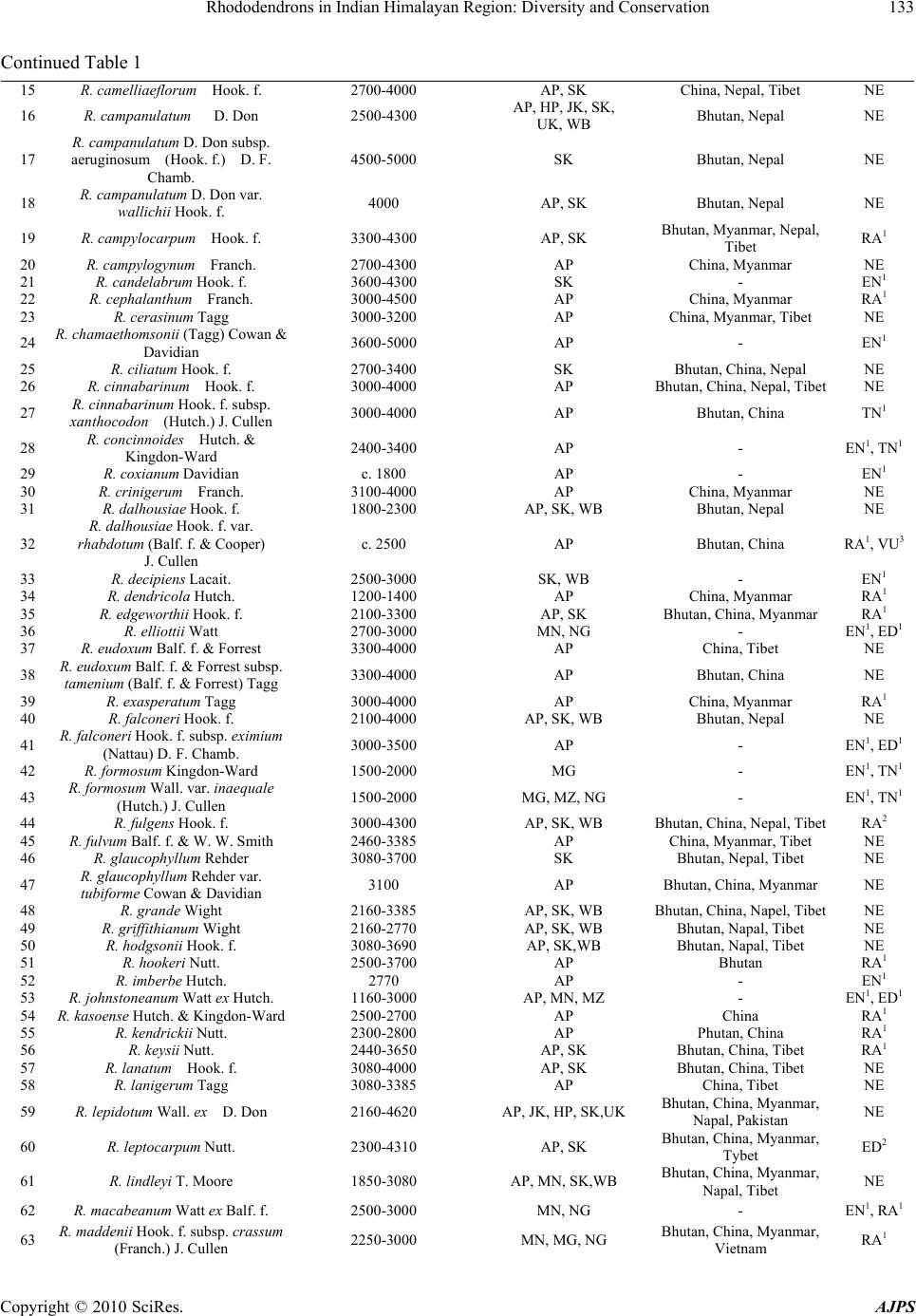 Rhododendrons in Indian Himalayan Region: Diversity and Conservation Copyright © 2010 SciRes. AJPS 133 Continued Table 1 15 R. camelliaeflorum Hook. f. 2700-4000 AP, SK China, Nepal, Tibet NE 16 R. campanulatum D. Don 2500-4300 AP, HP, JK, SK, UK, WB Bhutan, Nepal NE 17 R. campanulatum D. Don subsp. aeruginosum (Hook. f.) D. F. Chamb. 4500-5000 SK Bhutan, Nepal NE 18 R. campanulatum D. Don var. wallichii Hook. f. 4000 AP, SK Bhutan, Nepal NE 19 R. campylocarpum Hook. f. 3300-4300 AP, SK Bhutan, Myanmar, Nepal, Tibet RA1 20 R. campylogynum Franch. 2700-4300 AP China, Myanmar NE 21 R. cand elabrum Hook. f. 3600-4300 SK - EN1 22 R. cephalanthum Franch. 3000-4500 AP China, Myanmar RA1 23 R. cerasinum Tagg 3000-3200 AP China, Myanmar, Tibet NE 24 R. chamaethomsonii (Tagg) Co wan & Davidian 3600-5000 AP - EN1 25 R. ciliatum Hook. f. 2700-3400 SK Bhutan, China, N epal NE 26 R. cinnabar i num Hook. f. 3000-4000 AP Bhut an, China, Nepal, TibetNE 27 R. cinn a b arinum Hook. f. subsp. xanthocodon (Hutch.) J. Cullen 3000-4000 AP Bhutan, China TN1 28 R. concinnoides Hutch. & Kingdon-Ward 2400-3400 AP - EN1, TN1 29 R. coxianum Davidian c. 1800 AP - EN1 30 R. crinigerum Franch. 3100-4000 AP China, Myanmar NE 31 R. dal h o u s i a e Hook. f. 1800-2300 AP, SK, WB Bhutan, Nepal NE 32 R. dalho u s i a e Hook. f. var. rhabdotum (Balf. f . & Cooper) J. Cullen c. 2500 AP Bhutan, China RA1, VU3 33 R. decipiens Lacait. 2500-3000 SK, WB - EN1 34 R. dendricola Hutch. 1200-1400 AP China, Myanmar RA1 35 R. edgeworthii Hook. f. 2100-3300 AP, SK Bhutan, China, M yanmar RA1 36 R. elli ot t ii Watt 2700-3000 MN, NG - EN1, ED1 37 R. eudoxum Balf. f. & Forrest 3300-4000 AP China, Tibet NE 38 R. eudoxum Balf. f. & Forrest subsp. tamenium (Balf. f. & Forrest) Tagg 3300-4000 AP Bhutan, China NE 39 R. exasperatum Tagg 3000-4000 AP China, Myanmar RA1 40 R. falconeri Hook. f. 2100-4000 AP, SK, WB Bhutan, Nepal NE 41 R. falconeri Hook. f. subsp. eximium (Nattau) D. F. Chamb. 3000-3500 AP - EN1, ED1 42 R. formosum Kingdon-Ward 1500-2000 MG - EN1, TN1 43 R. formosum Wall. var. inaequale (Hutch.) J. Cullen 1500-2000 MG, MZ, NG - EN1, TN1 44 R. fulgens Hook. f. 3000-4300 AP, SK, WB Bhutan, China, Ne pal, TibetRA2 45 R. fulvum Balf. f. & W. W. Smi th 2460-3385 AP China, Myanmar, Tibet NE 46 R. glaucophyllum Rehder 3080-3700 SK Bhutan, Nepal, Tibet NE 47 R. glaucophyllum Rehder var. tubiforme Cowan & Davidian 3100 AP Bhutan, China, Myanmar NE 48 R. grande Wight 2160-3385 AP, SK, WB Bhutan, China, Napel, TibetNE 49 R. griffithianum Wight 2160-2770 AP, SK, WB Bhutan, Napal, Tibet NE 50 R. hodgsonii Hook. f. 3080-36 90 AP, SK,WB Bhutan, Napal, Tibet NE 51 R. hookeri Nutt. 2500-3700 AP Bhutan RA1 52 R. imberbe Hutch. 2770 AP - EN1 53 R. johnstoneanum Watt ex Hutch. 1160-3000 AP, MN, MZ - EN1, ED1 54 R. kasoense Hutch. & Kingdon-Ward 2500-2700 AP China RA1 55 R. kendrickii Nutt. 2300-2800 AP Phutan, China RA1 56 R. keysii Nutt. 2440-3650 AP, SK Bhutan, China, Tibet RA1 57 R. lanatum Hook. f. 3080-4000 AP, SK Bhutan, China, Tibet NE 58 R. lanigerum Tagg 3080-3385 AP China, Tibet NE 59 R. lepidotum Wall. ex D. Don 2160-4620 AP, JK, HP, SK,UK Bhutan, China, Myanmar, Napal, Pakistan NE 60 R. leptocarpum Nu tt. 2300-4310 AP, SK Bhutan, China, Myanmar, Tybet ED2 61 R. lindleyi T. Moore 1850-3080 AP, MN, SK,WB Bhutan, China, Myanmar, Napal, Tibet NE 62 R. macabeanum Watt ex Balf. f. 2500-3000 MN, NG - EN1, RA1 63 R. maddenii Hook. f. subsp. crassum (Franch.) J. Cullen 2250-3000 MN, MG, NG Bhutan, China, Myanmar, Vietnam RA1 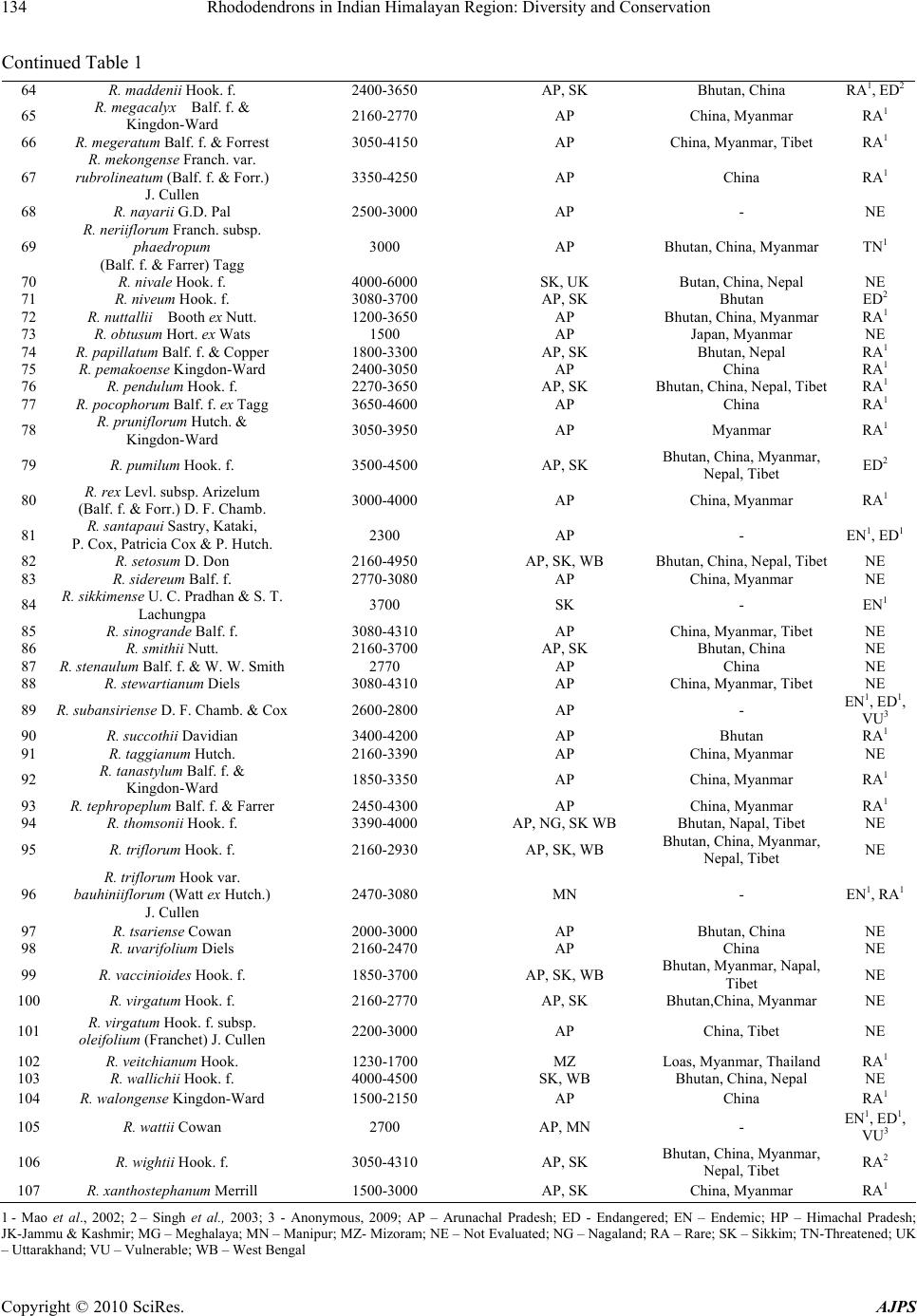 Rhododendrons in Indian Himalayan Region: Diversity and Conservation Copyright © 2010 SciRes. AJPS 134 Continued Table 1 64 R. maddenii Hoo k . f. 2400-3650 AP, SK Bhutan, China RA1, ED2 65 R. megacalyx Balf. f. & Kingdon-Ward 2160-2770 AP China, Myanmar RA1 66 R. megeratum Balf. f. & Forrest 3050-4150 AP China, Myanmar, Tibet RA1 67 R. mekongense Franch. var. rubrolineatum (Balf. f. & Forr.) J. Cullen 3350-4250 AP China RA1 68 R. nayarii G.D. Pal 2500-3000 AP - NE 69 R. neriiflorum Franch. subsp. phaedropum (Balf. f. & Farrer) Tagg 3000 AP Bhutan, China, Myanmar TN1 70 R. nivale Hook. f. 4000-6000 SK, UK Butan, China, Ne pal NE 71 R. niveum Hook. f. 3080-3 70 0 AP, SK Bhutan ED2 72 R. nuttallii Booth ex Nutt. 1200-3650 AP Bhutan, China, Myanmar RA1 73 R. obtusum Hort. ex Wats 1500 AP Japan, Myanmar NE 74 R. papillatum Balf. f. & C opper 1800-3300 AP, SK Bhutan, Nepal RA1 75 R. pemakoense Kingdon-Ward 2400-3050 AP China RA1 76 R. pendulum Hook. f. 2270-3650 AP, SK Bhutan, China, Ne pal, TibetRA1 77 R. pocophorum Balf. f. ex Tagg 3650-4600 AP China RA1 78 R. pruniflorum Hutch. & Kingdon-Ward 3050-3950 AP Myanmar RA1 79 R. pumilum Hook . f. 3500-4500 AP, SK Bhutan, China, Myanmar, Nepal, Tibet ED2 80 R. rex Levl. subsp. Arizelum (Balf. f. & Forr.) D. F. Chamb. 3000-4000 AP China, Myanmar RA1 81 R. santapaui Sastry, Kataki, P. Cox, Patricia Cox & P. Hutch. 2300 AP - EN1, ED1 82 R. setosum D. Don 2160-4950 AP, SK, WB Bhutan, China, Nepal, TibetNE 83 R. sidereum Balf. f. 2770-3080 AP China, Myanmar NE 84 R. sikkimense U. C. Pradhan & S. T. Lachungpa 3700 SK - EN1 85 R. sinogrande Balf. f. 3080-4310 AP China, Myanmar, Tibet NE 86 R. smithii Nutt. 2160-3700 AP, SK Bhutan, China NE 87 R. stenaulum B a lf. f. & W. W. Smith 2770 AP China NE 88 R. stewartianum Diels 3080-4310 AP China, Myanmar, Tibet NE 89 R. subansiriens e D. F. Chamb. & C o x 2600-2800 AP - EN1, ED1, VU3 90 R. succothii Davidian 3400-4200 AP Bhutan RA1 91 R. taggianum Hutch. 2160-3390 AP China, Myanmar NE 92 R. tanastylum Balf. f. & Kingdon-Ward 1850-3350 AP China, Myanmar RA1 93 R. tephropeplum Balf. f. & Farrer 2450-4300 AP China, Myanmar RA1 94 R. thomsonii Hook. f. 3390-4000 AP, NG, SK WB Bhutan, Napal, Tibet NE 95 R. triflorum Hook. f. 2160-2930 AP, SK, WB Bhutan, China, Myanmar, Nepal, Tibet NE 96 R. triflorum Hook var. bauhiniiflorum (W a tt ex Hutch.) J. Cullen 2470-3080 MN - EN1, RA1 97 R. tsariense Cowan 2000-3000 AP Bhutan, China NE 98 R. uvarifolium Diels 2160-2470 AP China NE 99 R. vaccinioides Hook. f. 1850-3700 AP, SK, WB Bhutan, Myanmar, Napal, Tibet NE 100 R. virgatum Hook. f. 2160-2770 AP, SK Bhutan,China, Myanmar NE 101 R. virgatum Hook. f. s ubsp . oleifolium (Franchet) J. Cullen 2200-3000 AP China, Tibet NE 102 R. veitchianum Hook. 1230-1700 MZ Loas, Myanmar, Thailand RA1 103 R. wallichii Hook. f. 4000-4500 SK, WB Bhutan, China, Nepal NE 104 R. walongense K ingdon-Ward 15 0 0-2150 AP China RA1 105 R. wattii Cowa n 2700 AP, MN - EN1, ED1, VU3 106 R. wightii Hook. f. 3050-4310 AP, SK Bhutan, China, Myanmar, Nepal, Tibet RA2 107 R. xanthostephanum Merrill 1500-3000 AP, SK China, Myanmar RA1 1 - Mao et al., 2002; 2 – Singh et al., 2003; 3 - Anonymous, 2009; AP – Arunachal Pradesh; ED - Endangered; EN – Endemic; HP – Himachal Pradesh; JK-Jammu & Kashmir; MG – Meghalaya; MN – Manipur; MZ- Mizoram; NE – Not Evaluated; NG – Nagaland; RA – Rare; SK – Sikkim; TN-Threatened; UK – Uttarakhand; VU – Vulnerable; WB – West Bengal  Rhododendrons in Indian Himalayan Region: Diversity and Conservation Copyright © 2010 SciRes. AJPS 135 Name of the States: AP – Arunachal Pradesh; HP – Himachal Pradesh; JK-Jammu & Kashmir; MG – Meghalaya; MN – Manipur; MZ- Mizoram; NG – Nagaland; SK – Sikkim; UK – Uttarakhand; WB – West Bengal Figure 1. Distribution of rhododendrons in different states of IHR. Altitudes (in m) A: 500-1000; B: 1000-1500; C: 1500-2000; D: 2000-2500; E: 2500-3000; F: 3000-3500; G: 3500-4000; H: 4000-4500; I: 4500-5000; J: >5000 Figure 2. Altitudinal diversity of rhododendrons in IHR. 4. Discussion The species of Rhododendrons exhibit significant diver- sity in habit and broad range of distribution from the al- titude of 800-6000 m. A total of 87 species, 12 subspe- cies and 8 varieties of Rhododendrons recorded in IHR. Out of these species, 20 taxa are endemic to IHR. While considering the status, 47 taxa are not yet evaluated, 30 are rare, 24 are threatened / endangered and 3 are vul- nerable [14,16,21]. In comparison with neighboring countries, China is having a total of 571 species of Rho- dodendrons, out of which 409 species are endemic [22] and other countries like Pakistan, Bhutan, Nepal, etc are having very less species diversity in Rhododendrons. A lot of exploration is still lacking to discover the species described in other parts of the country, because, the China and India is having similar habitat in support the growth of Rhododendrons. While considering the impor- tance of altitude the maximum number of Rhododen- drons present in the altitudes of 3001-3500 m. These altitudes are considered as best suitable sites for Rhodo- dendrons for conservation and multiplication. In the recent days, IHR is greatly affected due to vari- ous threat posed by the nature as well as by human be- ings. Since Rhododendrons are the inhabitants of the IHR, they are also greatly affected and their population in the nature is gradually dwind ling [14]. The rise in population with demand on land for farming, increased animal hus- bandry practices, construction of roadways, hydel-power stations and allied works, army personnel garrisoned at alpine locations and lately the tourist influx have collec- tively resulted in the building up of considerable pressu re on the availability of rhododendron species. The major threats to rhododendrons are deforestation and unsus- tainable extraction for firewood and incense by local people. Due to the presence of polyphenols and flavon- oids, rhododendrons make excellent firewood that burns even under wet conditions. Rhododendron firewood is also being used in the high-altitude trekking corridor for the purpose of tourism. Some of th e species have already become scarce, for example, R. leptocarpum is endan- gered and reported to have only 16 surviving individuals at present in the Sikkim [16]. The conservation of Rhododendron species can be ef- fected by two well established means, the in-situ and ex- situ methods. In-situ conservation can be brought about by establishing Rhododendron sanctuaries, Parks, etc. Some efforts by Sikkim forest department and Sikkim Rhododendron Society have been made by fencing the Rhododendron rich sites and declaring them as Rhodo- dendron Sanctuary between Lachung and Yumthang in the State. Similar efforts need to be made by Arunachal Pradesh Government as the state is home for more than 50 percent rare and endemic IHR species. The ex-situ conservation can be effected by cultivating Rhododen- dron species in the gardens and parks under suitable cli- matic conditions or by using tissue culture techniques. There should not be many difficulties in introducing these species in Botanic Gardens and Parks as most of them have successfully b een introduced and cultivated in the European and American countries. The species of Rhododendron arboreu m are prop ag ated thro ugh cu ttings [23,24]. Tissue culture studies of Indian Rhododendrons are recently initiated; only few species especially Rho- dodendron maddeni has only been propagated through tissue culture methods (Singh and Gurung, 2009) and some others are under progress. But in for eign countries, the Rhododendrons have already been carried out for commercial cultivation [26-32]. The standard culture medium for tissue culture methods is read ily available in the market [14]. Successful tissue culture of these species will be a great contribution for rapid multiplication and 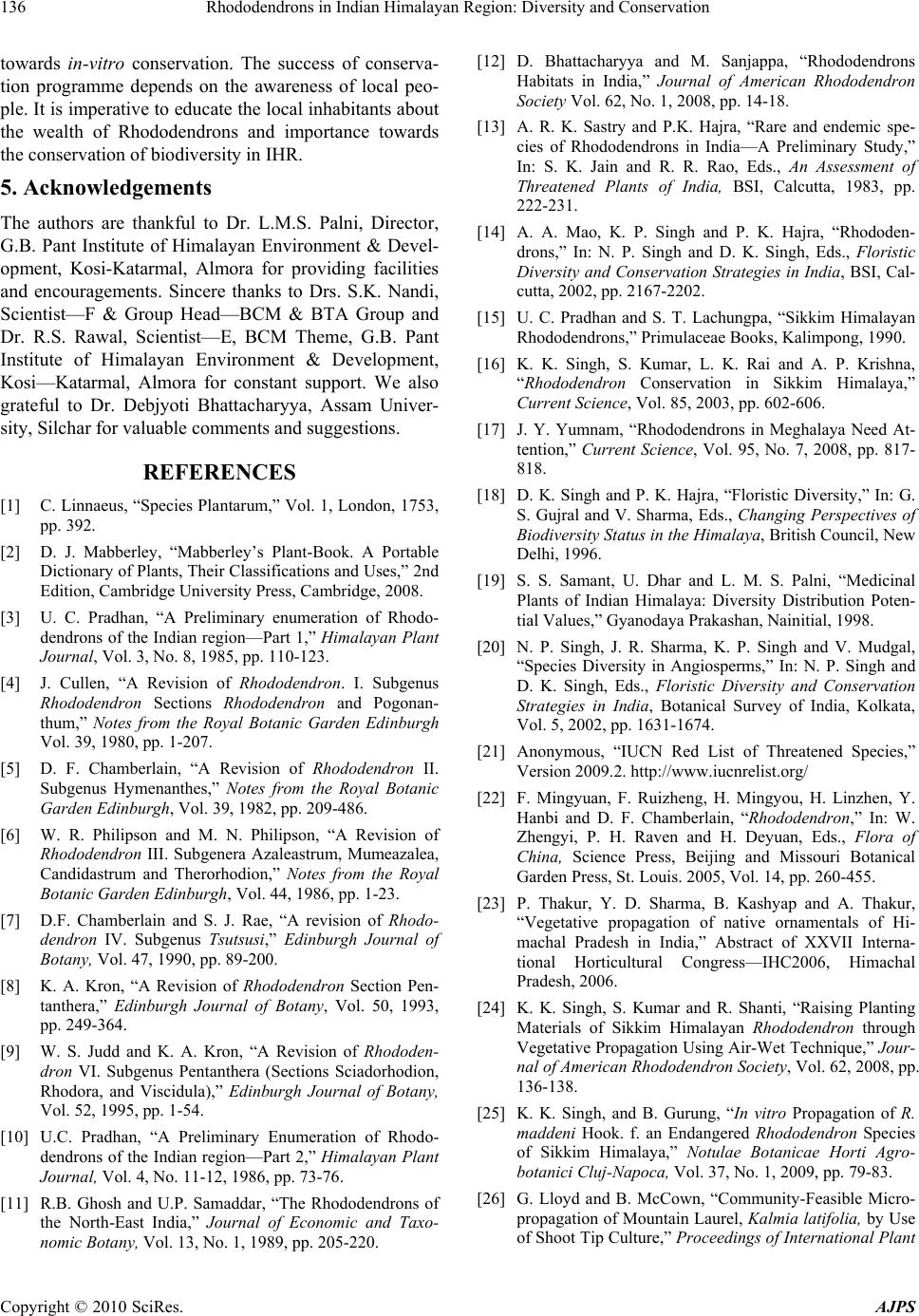 Rhododendrons in Indian Himalayan Region: Diversity and Conservation Copyright © 2010 SciRes. AJPS 136 towards in-vitro conservation. The success of conserva- tion programme depends on the awareness of local peo- ple. It is imperative to educate the local inhabitants abou t the wealth of Rhododendrons and importance towards the conservation of biodiversity in IHR. 5. Acknowledgements The authors are thankful to Dr. L.M.S. Palni, Director, G.B. Pant Institute of Himalayan Environment & Devel- opment, Kosi-Katarmal, Almora for providing facilities and encouragements. Sincere thanks to Drs. S.K. Nandi, Scientist—F & Group Head—BCM & BTA Group and Dr. R.S. Rawal, Scientist—E, BCM Theme, G.B. Pant Institute of Himalayan Environment & Development, Kosi—Katarmal, Almora for constant support. We also grateful to Dr. Debjyoti Bhattacharyya, Assam Univer- sity, Silchar for valuable comments and suggestions. REFERENCES [1] C. Linnaeus, “Species Plantarum,” Vol. 1, London, 1753, pp. 392. [2] D. J. Mabberley, “Mabberley’s Plant-Book. A Portable Dictionary of Plants, Their Classifications and Uses,” 2nd Edition, Cambridge University Press, Cambridge, 2008. [3] U. C. Pradhan, “A Preliminary enumeration of Rhodo- dendrons of the Indian region—Part 1,” Himalayan Plant Journal, Vol. 3, No. 8, 1985, pp. 110-123. [4] J. Cullen, “A Revision of Rhododendron. I. Subgenus Rhododendron Sections Rhododendron and Pogonan- thum,” Notes from the Royal Botanic Garden Edinburgh Vol. 39, 1980, pp. 1-207. [5] D. F. Chamberlain, “A Revision of Rhododendron II. Subgenus Hymenanthes,” Notes from the Royal Botanic Garden Edinburgh, Vol. 39, 1982, pp. 209-486. [6] W. R. Philipson and M. N. Philipson, “A Revision of Rhododendron III. Subgenera Azaleastrum, Mumeazalea, Candidastrum and Therorhodion,” Notes from the Royal Botanic Garden Edinburgh, Vol. 44, 1986, pp. 1-23. [7] D.F. Chamberlain and S. J. Rae, “A revision of Rhodo- dendron IV. Subgenus Tsutsusi,” Edinburgh Journal of Botany, Vol. 47, 1990, pp. 89-200. [8] K. A. Kron, “A Revision of Rhododendron Section Pen- tanthera,” Edinburgh Journal of Botany, Vol. 50, 1993, pp. 249-364. [9] W. S. Judd and K. A. Kron, “A Revision of Rhododen- dron VI. Subgenus Pentanthera (Sections Sciadorhodion, Rhodora, and Viscidula),” Edinburgh Journal of Botany, Vol. 52, 1995, pp. 1-54. [10] U.C. Pradhan, “A Preliminary Enumeration of Rhodo- dendrons of the Indian region—Part 2,” Himalayan Plant Journal, Vol. 4, No. 11-12, 1986, pp. 73-76. [11] R.B. Ghosh and U.P. Samaddar, “The Rhododendrons of the North-East India,” Journal of Economic and Taxo- nomic Botany, Vol. 13, No. 1, 1989, pp. 205-220. [12] D. Bhattacharyya and M. Sanjappa, “Rhododendrons Habitats in India,” Journal of American Rhododendron Society Vol. 62, No. 1, 2008, pp. 14-18. [13] A. R. K. Sastry and P.K. Hajra, “Rare and endemic spe- cies of Rhododendrons in India—A Preliminary Study,” In: S. K. Jain and R. R. Rao, Eds., An Assessment of Threatened Plants of India, BSI, Calcutta, 1983, pp. 222-231. [14] A. A. Mao, K. P. Singh and P. K. Hajra, “Rhododen- drons,” In: N. P. Singh and D. K. Singh, Eds., Floristic Diversity and Conservation Strategies in India, BSI, Cal- cutta, 2002, pp. 2167-2202. [15] U. C. Pradhan and S. T. Lachungpa, “Sikkim Himalayan Rhododendrons,” Primulaceae Books, Kalimpong, 1990. [16] K. K. Singh, S. Kumar, L. K. Rai and A. P. Krishna, “Rhododendron Conservation in Sikkim Himalaya,” Current Science, Vol. 85, 2003, pp. 602-606. [17] J. Y. Yumnam, “Rhododendrons in Meghalaya Need At- tention,” Current Science, Vol. 95, No. 7, 2008, pp. 817- 818. [18] D. K. Singh and P. K. Hajra, “Floristic Diversity,” In: G. S. Gujral and V. Sharma, Eds., Changing Perspectives of Biodiversity Status in the Himalaya, British Council, New Delhi, 1996. [19] S. S. Samant, U. Dhar and L. M. S. Palni, “Medicinal Plants of Indian Himalaya: Diversity Distribution Poten- tial Values,” Gyanodaya Prakashan, Nainitial, 1998. [20] N. P. Singh, J. R. Sharma, K. P. Singh and V. Mudgal, “Species Diversity in Angiosperms,” In: N. P. Singh and D. K. Singh, Eds., Floristic Diversity and Conservation Strategies in India, Botanical Survey of India, Kolkata, Vol. 5, 2002, pp. 1631-1674. [21] Anonymous, “IUCN Red List of Threatened Species,” Version 2009.2. http://www.iucnrelist.org/ [22] F. Mingyuan, F. Ruizheng, H. Mingyou, H. Linzhen, Y. Hanbi and D. F. Chamberlain, “Rhododendron,” In: W. Zhengyi, P. H. Raven and H. Deyuan, Eds., Flora of China, Science Press, Beijing and Missouri Botanical Garden Press, St. Louis. 2005, Vol. 14, pp. 260-455. [23] P. Thakur, Y. D. Sharma, B. Kashyap and A. Thakur, “Vegetative propagation of native ornamentals of Hi- machal Pradesh in India,” Abstract of XXVII Interna- tional Horticultural Congress—IHC2006, Himachal Pradesh, 2006. [24] K. K. Singh, S. Kumar and R. Shanti, “Raising Planting Materials of Sikkim Himalayan Rhododendron through Vegetative Propagation Using Air-Wet Technique,” Jour- nal of American Rhododendron Society, Vol. 62, 2008, pp. 136-138. [25] K. K. Singh, and B. Gurung, “In vitro Propagation of R. maddeni Hook. f. an Endangered Rhododendron Species of Sikkim Himalaya,” Notulae Botanicae Horti Agro- botanici Cluj-Napoca, Vol. 37, No. 1, 2009, pp. 79-83. [26] G. Lloyd and B. McCown, “Community-Feasible Micro- propagation of Mountain Laurel, Kalmia latifolia, by Use of Shoot Tip Culture,” Proceedings of International Plant  Rhododendrons in Indian Himalayan Region: Diversity and Conservation Copyright © 2010 SciRes. AJPS 137 Propagation Society, Vol. 30, 1981, pp. 421-427. [27] W. C. Anderson, “A revised Medium for Shoot Prolifera- tion of Rhododendron,” Journal of American Society & Horticultural Science, Vol. 109, 1984, pp. 343-347. [28] G. C. Douglas, “Propagation of Eight Cultivars of Rhodo- dendron in vitro Using Agar-Solidified and Liquid Media and Direct Rooting of Shoots in vivo,” Scientia Horticul- turae, Vol. 24, 1984, pp. 337-347. [29] B.H. McCown and G.B. Lloyd, “A Survey of the Re- sponse of Rhododendrons to in vitro Cultures,” Plant cell tissue and organ culture, Vol. 2, 1985, pp. 77-85. [30] B. A. Briggs, S. M. McCulloch and L. A. Caton, “In vitro propagation of Rhododendron,” Acta Horticulturae, Vol. 364, 1994, pp. 21-26. [31] P. W. Evers, J. Donkers, A. Prat and E. Vermeer, “Mi- cropropagation of forest trees through tissue culture,” Centre for Agricultural Publishing and Documentation, Wageningen, 1988. [32] R. Almeida, S. Gonçalves and A. Romano, “In vitro Mi- cropropagation of Endangered Rhododendron ponticum L. subsp. baeticum (Boissier & Reuter) Handel-Mazzetti,” Biodiversity and Conservation Vol. 14, No. 5, 2005, pp. 1059-1069. |

